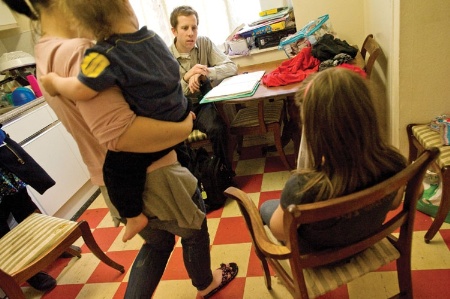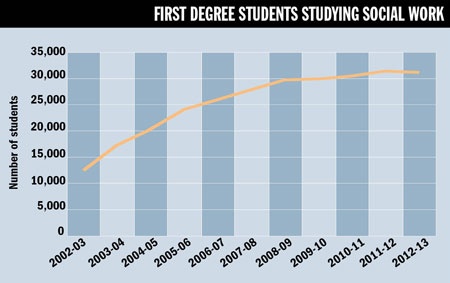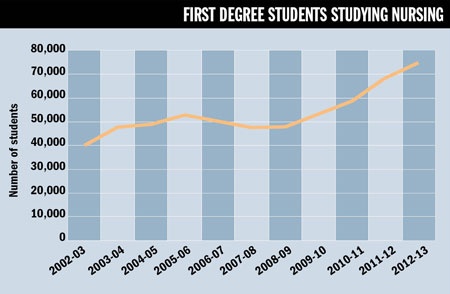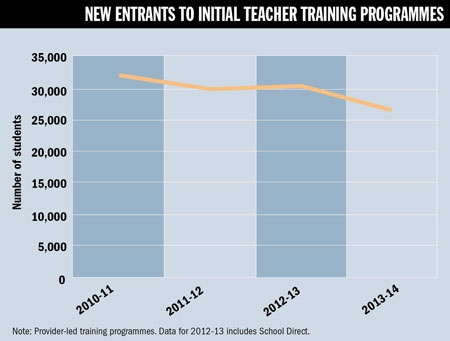Source: Getty
Policing
Uniform aims on the thin blue line
Individual officers do work closely with higher education institutions but most view research and evidence-based practice as remote from their day jobs
“With 43 forces in England and Wales, there are 43 different ways of doing things,” Stuart Norton, director of the Institute of Professional Policing at Bucks New University, says of the relationship between universities and police forces.
Some areas of the UK boast excellent links between academia and policing, which have resulted in foundation degree courses to cultivate new recruits and continuing professional development courses for existing officers; but in other regions, universities and local police forces still work in silos.
Bucks New enjoys a strong relationship with the local service, Thames Valley Police. In addition to providing several police-related undergraduate degree courses, the university is one of eight higher education institutions to offer a two-year foundation degree in policing or police studies. The first students are about to graduate from the foundation degree course, and 23 of them are already guaranteed a job in policing. Next year, the number of graduates will almost double.
Norton says the programme was developed, in cooperation with Thames Valley Police and Oxford Brookes University, to address some of the problems that services around the country were encountering when hiring new recruits. Eighteen-year-olds applying to enter the profession often lacked the experience to show that they could handle the situations they would encounter as an officer.
“This was a chance to write a programme that would have options built in to give them the experience they need, and also to get them a degree,” Norton says.
In February last year, the College of Policing was formally launched to take on the training and development role that was previously the responsibility of the now-dissolved National Policing Improvement Agency.
Would-be police officers complete a diploma as part of their training, but the new certificate of knowledge in policing (CKP), introduced by the college, gives future officers the opportunity to complete part of their diploma before joining a force.
There are about 60 approved CKP providers, of which 13 are universities. However, the way in which the different police forces treat the qualification further highlights regional discrepancies.
It is up to local chief constables to decide whether or not to require new recruits to have a CKP; even among those that do, there is variation. In London, the Metropolitan Police, for example, puts candidates through all the other recruitment processes first, and only if they complete them successfully will it require a candidate to acquire the certificate.
“Part of the problem at the moment is getting a handle on the local patchwork of approaches that are springing up,” says Martin Innes, director of the Universities’ Police Science Institute at Cardiff University.
“There are a number of arrangements in place, ranging from short, sharp inputs on specialist topics – such as getting universities to give expert help with an issue that the police are working on – to the really interesting developments in the partnership arena, with the foundation courses and continuing professional development being delivered by universities on behalf of the police.”
Among the constabularies working closely with universities is Merseyside Police, which, with the University of Liverpool, developed a series of seminars that matched the service’s needs. The sessions – on decision-making, criminal behaviour, police power, public order and protest, and gang crime – were delivered on site at Merseyside Police Headquarters.
Rachel Tuffin, head of research at the College of Policing, says that one of the college’s aims is to develop in services nationwide a more structured approach to CPD, including the establishment of better links to academia.
“We want to introduce formal CPD for police officers, which means we will be encouraging them to seek opportunities to improve in all sorts of ways – some of which would be in partnership with universities.”
Currently there are examples of individual officers working closely with higher education institutions, she says, but most officers view research and evidence-based practice as something remote from their day-to-day job.
Despite advocating a more structured approach to training on the job, Tuffin dismisses any suggestion that the College of Policing would consider making policing a degree-level profession, as has happened in nursing and social work. “There is no intention in policing to have graduate entry,” she says. “Personally,” adds Norton, “I would not advocate that every officer have a degree. My fear would be that the cost of education might be prohibitive. I would worry that we might be putting up more barriers to entry.”
Chris Parr

Social work
Pulled in different directions
Confusion about the plethora of standards, guidance and requirements causes concern to employers and academics
In February, two separate government departments published separate reports on social work education, both of which contained multiple recommendations about how to improve universities’ approach to the subject.
While the Department of Health commissioned David Croisdale-Appleby, an honorary professor at Durham University’s Wolfson Research Institute and its School of Medicine and Health, to write Re-visioning Social Work Education: An Independent Review, the Department for Education asked Sir Martin Narey, former chief executive of children’s charity Barnardo’s, to produce Making the Education of Social Workers Consistently Effective.
Although there is some common ground, the two reports disagree on several key aspects of social worker education. For example, Narey backs the introduction of a specialised qualification for those who wish to work with children, while Croisdale-Appleby wants to retain a generic qualification for university social work students. Whatever is decided, the outcome will have a significant impact on how universities develop social work degrees, which were introduced as qualifying degrees in 2003.
Such inconsistencies leave social work education in England on uncertain footing, with recommendations from both reports being considered by the departments that commissioned them. The fact that two separate reports appeared simultaneously demonstrates “a clear disunity and lack of understanding within political circles”, which “does not bode well” for the discipline, says Jonathan Parker, deputy dean for research and enterprise and director of the Centre for Social Work and Social Policy at Bournemouth University.
But such treatment does not surprise John Cater, vice-chancellor of Edge Hill University, who says: “This is not a profession with historically a clear identity, either in government or more broadly.” Cater was Universities UK’s representative on the Social Work Reform Board, which oversaw reforms to the profession after the death of “Baby P” in 2007.
In 2009, the Social Work Task Force, set up by the Department of Health and the Department for Children, Schools and Families in the wake of Baby P’s death, called for social work degrees to be overhauled, for improvements to placements (which it found could suffer from problems such as poor supervision) and for employers and educators to work more closely amid “strong concerns…about the calibre of some lecturers and tutors” and their understanding of how theory was applied in practice. It also recommended more rigorous assessment of social work applicants by universities, an issue that has not gone away.
Both the Croisdale-Appleby and the Narey reports make recommendations about the number of Ucas tariff points that social work degree applicants should obtain. The former advocates a minimum of 300 – the equivalent of three Bs at A level – while the latter casts doubt over the current accepted minimum of 240. “No Russell Group university, and only a small minority of others, will allow any student to study for a degree in any subject with such indifferent grades,” Narey writes.
But Cater counters that his university is able to be highly selective about the applicants it accepts on to social work programmes. The undergraduate course at Edge Hill has a minimum Ucas tariff of 280. “In my view, the quality of applicants for undergraduate social work has picked up quite dramatically in recent years,” he says. “We are looking at 10, maybe 12, applicants per place, which gives us an awful lot of choice in terms of recruitment, and we are able to get people who are both intellectually able and empathetic to the profession.”
Five years ago, the Social Work Task Force also called for an end to the confusion caused by the different bodies involved in training, which set different standards and requirements. Since 2012, the Health and Care Professions Council has regulated social work education in England, publishing standards of education and training.

However, Croisdale-Appleby’s report refers to the continuing “complexity of the current situation…compounded by the need to adhere to the standards set by the Quality Assurance Agency for Higher Education which sets its own benchmark statements about social work…It is clear that the confusion about this plethora of standards, guidance and requirements causes concern to employers and academics, and raises profound doubts about whether it provides a clear guide to what a newly qualified social worker needs to know, understand and be able to do.”
He also found that too many social workers were qualifying for the number of roles available, adding that workforce planning for social workers is currently “inadequate, and will need to be radically improved”. Symptoms of that inadequacy include the number of qualified social workers who choose to not practise, and the number who are “unable to gain employment with social work providers”.
The situation would be even more severe, he says, were it not for the “unwelcome lack of retention of social workers in practice” within a few years of qualifying. According to a 2013 study by healthcare recruitment agency Randstad Care, there will be a shortage of 10,600 social workers by 2050 because of a national skills shortage and an ageing current workforce.
Perhaps more threatening to universities than questions about the nature and coherence of their provision are alternative routes into the profession for existing graduates, which ministers are exploring. These pathways include “Step Up to Social Work”, which is targeted at people looking to change career, and “Frontline”, a controversial programme that targets recent graduates who might not have considered a career in children’s social work specifically.
The latter has been compared to the more established Teach First programme. In it, accepted candidates complete an intensive five-week training camp at a university before starting work under a consultant social worker. The scheme is backed by Michael Gove, the education secretary, and by the College of Social Work, which vets any universities wishing to take part. About 2,600 graduates applied for the first 100 advertised places on Frontline, with 108 candidates selected for training that is due to start later this year. Of those accepted, 73 per cent are from Russell Group institutions, including 20 per cent from the University of Oxford or the University of Cambridge.
Despite its popularity, the programme has attracted criticism from academics. A statement issued last year by the Joint University Council’s Social Work Education Committee and the Association of Professors of Social Work raised questions about the “narrow” child-protection focus of the programme, the implications such a “fast-track” approach might have for existing master’s and other postgraduate courses, and the scheme’s cost.
“These ill-thought initiatives have caused conflict,” says Bournemouth’s Parker, adding that it had been to “some significant dismay for many in the higher education sector” that the Frontline initiative was taken forward, and subsequently backed by some universities. The academic aspect of the programme is led by the University of Bedfordshire’s Tilda Goldberg Centre, the Institute of Family Therapy and the Institute of Psychiatry at King’s College London.
The next few years could be a defining period for social work education as the two reports are considered and the effectiveness of Frontline is assessed. Parker is concerned that if traditional courses do end up being sidelined in favour of the extension of fast-track routes into the profession, the discipline could become less important to universities.
“Social work education and research in the UK is among the best in the world,” he says. “It is attacked at society’s peril. If the two reports and their recommendations further encroach on the time academics can spend doing research into social work, and with their practitioner colleagues, it is possible that more universities will withdraw from offering these expensive and, without research, low-return programmes.”
Chris Parr
Social work: the biggest providers (2012-13)
| Institution | Students |
|---|---|
| Note: All first degree students Source: Higher Education Statistics Agency | |
| The Open University | 5,555 |
| Canterbury Christ Church University | 890 |
| University of Central Lancashire | 835 |
| University of Sunderland | 820 |
| University of Ulster | 735 |
| University of Huddersfield | 730 |
| University of Northumbria | 685 |
| Nottingham Trent University | 625 |
| University of Wolverhampton | 625 |
| Manchester Metropolitan University | 580 |

Nursing
Cut to the quick
The main challenge is underinvestment in nursing science and ensuring that we build the capacity so we can increase the number of nurse scientists
The public inquiry into what went wrong in the Mid Staffordshire NHS Foundation Trust that was responsible for Stafford Hospital, which recorded unusually high death rates between 2005 and 2009, heard appalling stories of patients left in soiled bedclothes, in pain and without water, some becoming so dehydrated that they had to resort to drinking water from vases.
The resulting report by Robert Francis QC, published in early 2013, also raised questions about nursing degrees. The inquiry heard concerns “that today’s nursing training contains an inadequate quantity of practical experience at an early stage”.
While “most of those with whom the inquiry had contact agreed that the increasingly technical demands of the role required degree-level training and education…they recognised that the progress made in this direction had sometimes been at the expense of exposure to personal experience of the basic tasks that all nurses should be able and willing to do”, the report says.
Roger Watson, professor of nursing at the University of Hull, says it is “nonsense” to argue that a lack of practical nursing education played a part in the scandal. “The percentage of time that student nurses spend in clinical practice has never changed. It has always been at least 50 per cent,” he says.
The claim that higher education might somehow make people less caring “is ridiculous” – and it is not one made about doctors, he adds.
David Barton, head of the department of nursing at Swansea University, argues that “people leave universities well prepared for their job”, but some nursing work in the NHS can lead to “burnout”.
The shift in nursing training from a three-year diploma to a three-year degree has come into force through the Nursing and Midwifery Council’s 2010 standards, which all universities in England must meet when training and educating nurses. This has brought England in line with Wales, Scotland and Northern Ireland, where degrees were already the norm.
The aim of the change was to bolster competencies in higher-level skills. Not only have many patients’ needs grown more complex as a result of the ageing population, but nurses are also now regularly asked to take on more advanced roles and required to work more autonomously in the community.
Universities in England that offer nursing degrees are paid a set amount per student by Health Education England, a body established in 2012 that plans and commissions health education and training, to cover the course costs.
However, recent analysis calls into question whether the amount is sufficient.
The figure, known as the benchmark price, was set in 2002. It was designed to make nursing education more consistent and to push universities to compete on quality rather than on price. It is reviewed every five years, and the latest round of consultation is now under way.
A briefing paper published in March by Universities UK and the Council of Deans of Health suggests that there is a funding shortfall for universities offering nursing, midwifery and allied health practitioner courses of between 7.6 and 11.5 per cent.
“This means that it is likely that universities are already cross-subsidising from other activities to be able to provide pre-registration education,” says the report, Nursing, Midwifery and AHP Pre-registration Education: The Funding Gap.

Health Education England is now proposing cuts of about 4 per cent to the benchmark price, which would exacerbate the shortfall.
“[A]ny cuts that further widen the gap risk not only a significant negative impact on the quality of education but could also result in some universities withdrawing from pre-registration provision altogether,” the Funding Gap report claims.
Indeed, Barton adds, the funding shortfall means that universities “view nursing in somewhat of a dim light”. However, he points out that “it is centrally commissioned, so it means there is a large lump sum that comes to [a] university on an annual basis”.
Overall, the number of nurses that are trained each year is set by Health Education England’s local education and training boards and, in Wales, by the Workforce, Education and Development Services.
After four years of decline, the number of nurses trained each year began climbing in 2009-10, according to data on first-degree students on nursing courses from the Higher Education Statistics Agency. In 2012-13, almost 75,000 students embarked on a nursing degree, up from 47,500 in 2008-09.
Jessica Corner, vice-chair of the UK Council of Deans of Health, says that evidence suggests that hospitals with higher numbers of degree-qualified nurses have lower death rates. “Research-led education for nurses is the gold standard,” she says. “The main challenge is serious underinvestment in nursing science and ensuring that we build the capacity so that we can substantially increase the number of nurse scientists.”
For the university portion of their degree, would-be nurses are taught biological sciences, medicine and social sciences in lecture theatres and practise their clinical skills in laboratories.
One of the Francis report’s recommendations is that the NMC and other professional and academic bodies work towards establishing a common national qualifying examination for nurses.
Watson says that a single exam could allow new nurses to be measured at entry into practice, as is already the case in some countries.
But Barton thinks such a move would be naive. “It is a knee-jerk reaction [to Francis],” he says. “The checks and balances to ensure that the programmes are delivering according to set national standards are already there.”
Institutions may educate and train nurses only with NMC approval, which usually lasts for five years. Each year, institutions must submit a report outlining their adherence to the standards, and some are selected to undergo inspections carried out by a consultancy on behalf of the NMC.
A proportion of the institutions earmarked for inspection are selected at random, but some are selected for scrutiny on the basis of specific risk information gathered from regulatory reports and other intelligence collected by the NMC. In 2013-14, 16 universities are scheduled for inspection.
The shadow of the Mid Staffordshire scandal still looms over nursing education. Later this year, the NMC will undertake an independent review of its 2010 standards in the light of the Francis report.
One reform proposed in the wake of the scandal was that would-be nurses work for at least three months as a nursing auxiliary before beginning a course of study. A pilot scheme is now under way at 10 locations across the country. Watson is sceptical. “There is just no evidence that giving people that kind of experience makes them more caring, and there is plenty of anecdotal evidence that says it makes them worse because you pick up a lot of bad habits.”
Holly Else
Nursing: the biggest providers (2012-13)
| Institution | Students |
|---|---|
| Note: All first degree students Source: Higher Education Statistics Agency | |
| University of the West of England | 2,565 |
| Birmingham City University | 2,195 |
| University of Northumbria | 2,180 |
| University of the West of Scotland | 2,175 |
| Anglia Ruskin University | 2,125 |
| Edinburgh Napier University | 2,070 |
| Glasgow Caledonian University | 1,880 |
| Edge Hill University | 1,780 |
| University of Salford | 1,775 |
| University of Plymouth | 1,715 |

Teaching
Classroom disruptions and interventions
The landscape of teacher training, in which universities have long been a fixture, is in a state of tumult. University schools of education have been hit for six by the rapid expansion of the government’s School Direct programme.
Under the flagship Department for Education scheme, which was launched in September 2012, schools can recruit teacher trainees directly and decide what type of provider they would like to work with in developing those they hire. “The idea is a simple one: take the very best schools…and put them in charge of teacher training and professional development for the whole system,” Michael Gove, the education secretary, said in June 2012. “By the end of this Parliament, well over half of all training places will be delivered by schools.”
Since School Direct started, most universities have suffered substantial reductions to their core teacher training provision as the government has transferred teacher training places to the scheme.
When the distribution of places for 2014-15 was revealed in November 2013, an analysis by the Universities’ Council for the Education of Teachers showed that the total core – undergraduate and postgraduate – allocations at higher education institutions would drop by about 14.5 per cent from 2013-14 – from 26,790 to 22,900. At the same time, the government assigned 15,400 places to School Direct, a leap of more than 60 per cent from 2013-14.
At a recent Westminster Education Forum on the future of teacher training, James Noble-Rogers, Ucet’s executive director, said that this shift had taken place despite the continuing popularity of university-led provision, while Patrick Roach, deputy general secretary of the NASUWT teachers’ union, argued that there should be no “presumption” against higher education programmes in policy circles.
“One of the lessons from the international evidence is while school-led programmes have an important role to play in terms of building a profession for the future, that shouldn’t come at the expense or to the detriment of higher education-led programmes,” Roach told the conference.
Peter Strike, vice-chancellor of the University of Cumbria, thinks “the speed of change and the lack of joined-up behaviour from the various contributors to the new models” are proving “every bit as challenging” as anticipated. “It could be the basis of something very positive with schools, but it does require the evolution of a level of understanding between the various contributors to the process, which isn’t yet in place.”
Although universities still have responsibility for the quality of training programmes they deliver via School Direct, schools take charge of the recruitment.
“If schools recruit only half the number of students they have applications for places for, it doesn’t affect them very much,” Strike says. “There’s no consequence financially for them, in particular. But aggregated for us, it’s hugely important, because we can see 50 per cent of our business disappear if schools recruit only half the numbers that they say they wanted.”
Strike predicts under-recruitment to School Direct across the sector, which could potentially lead to a shortage of teachers.
“For all the proclaiming [by the National College for Teaching and Leadership] that School Direct was a huge success last year, we all know there was a hideous under-recruitment of maths and physics teachers and an over-recruitment in history and English,” Strike says.
Another complication on the teacher training scene has been Ofsted inspections. Higher education institutions rated as “outstanding” by Ofsted for initial teacher education had their core allocations protected in 2012-13 and 2013-14. However, Ofsted changed its inspection framework in 2012 to make it more rigorous. Some universities subjected to this tougher scrutiny were downgraded and lost student numbers as a result, but institutions that had been awarded “outstanding” ratings under the previous, lighter regime maintained their numbers. With Ofsted making more changes this summer, some universities will escape the “onerous” inspection.
Strike thinks this is unfair.

“If there is a burning issue of inequality and bad feeling, then that’s it,” he says. “This has hammered places like Liverpool Hope University – it put them down at grade three – and it has taken us from ‘outstanding’ to ‘good’. “The financial consequences have been absolutely huge. Ofsted decisions have cost us something like £4 million over the past two years.”
John Cater, vice-chancellor of Edge Hill University, also has grave concerns. Outside some subjects, student demand for teacher training courses “is beginning to look fragile”, he says. “This historically would be unexpected: secure public sector professions tend to see significant increases in times of recession. But there is sufficient uncertainty in initial teacher training to make demand very flaky.”
He points to 2013-14 figures that show that School Direct signed up only 6,300 entrants out of a goal of 9,600, roughly 66 per cent of target. At the same time, universities, “though in a challenging market”, recruited about 95 per cent of their target.
As for the mix of subjects that applicants hope to teach, “I think it’s pretty frightening,” he says. “Applications in the School Direct system [to shortage subjects] are likely to be few in number. The only people who are going to recruit significant numbers of physics teachers are universities teaching undergraduate physics or with a history of successfully recruiting trainee physics teachers.”
The university sector’s fears are not “alarmist”, stresses Noble-Rogers. “Radically changing a system that’s successfully delivered 35,000 teachers a year is potentially reckless.” He worries that too quick and too broad an expansion of a school-led system could lead to “a loss of quality provision” – as universities channel resources elsewhere – and thus to “reduced choice for schools”.
Universities UK’s most recent parliamentary briefing echoes these concerns. It expresses unease from its members that cuts to core allocations, subsequently transferred to School Direct, would “make it difficult to sustain teacher training provision, including their capacity to support school-led routes”.
Sustainability of provision is not UUK’s only worry, says Greg Wade, the group’s programme manager for teacher education. “The other concern we have is where the allocations lead to very small cohort sizes in subjects, where universities are having to rearrange their resources to maintain provision.
“Many universities are directing applicants who can’t get on their core places to School Direct,” he continues. “There’s no guarantee, however, that students who want to do a postgraduate certificate in education on a university-led course will actually go to it as an alternative.”
Although scepticism has marked some universities’ reactions to the changes, others view them with a touch more pragmatism.
“I’m still very positive about [a schoolled system] in terms of the philosophy, and I don’t think there is an intention to drive universities out of it,” says Samantha Twiselton, director of the Sheffield Institute for Education at Sheffield Hallam University. The institution has done much to involve itself in the process of change. For the work it has done in the move towards the new system, the university was singled out for praise by Charlie Taylor, chief executive of the National College for Teaching and Leadership, the government agency that allocates teacher training places.
Twiselton says there are some things that “the teaching and outstanding schools can do better than we can because they’re at the cutting edge of practice, doing it on a daily basis”.
“What I pick up from other universities in the sector is that they’re just not willing to give any of that ground away,” she adds. “Yet I know from my own experience that you produce better teachers if you recognise that expertise.”
However, partnership is the key, she notes, and schools recognise that “exposure to research, school-to-school improvement and continuing professional development” is an important part of being a good classroom practitioner.
Some institutions, such as the University of Bath and The Open University, have already dropped their PGCEs, but Cater hopes that other higher education providers will “hang in there”. Initial allocations for 2015-16, due to be published later this year, may clarify universities’ next steps.
John Elmes
Teaching: the biggest providers
Initial teacher training places allocated to universities for 2014-15
| Institution | Students |
|---|---|
| Note: Undergraduate and postgraduate places Source: National College for Teaching and Leadership and Department for Education | |
| Edge Hill University | 1,444 |
| Manchester Metropolitan University | 1,040 |
| Canterbury Christ Church University | 979 |
| University of Cumbria | 840 |
| Institute of Education, University of London | 764 |
| University of Brighton | 639 |
| University of Worcester | 588 |
| Birmingham City University | 562 |
| St Mary’s University College | 557 |
| Bath Spa University | 539 |
Register to continue
Why register?
- Registration is free and only takes a moment
- Once registered, you can read 3 articles a month
- Sign up for our newsletter
Subscribe
Or subscribe for unlimited access to:
- Unlimited access to news, views, insights & reviews
- Digital editions
- Digital access to THE’s university and college rankings analysis
Already registered or a current subscriber? Login





